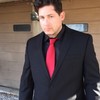Image via Wikipedia Creative Commons
Advertisement
Image courtesy of Scott M. Deitche and Perfect Paperboy
Scott M. Deitche: I wrote a spirits column for Cigar City Magazine for a couple years and my agent suggested I put together a project on the favorite drinks of writers. The original idea was a book called Literary Libations. My agent shopped it around and it didn't get a lot of traction, so I wanted to retool it.I tweaked the idea to focus on the favorite drinks and bars of crime writers and gangsters, partly because most of the authors I know write about crime. From there, I thought adding in real life gangsters was a natural progression, as well as drinks featured in gangster movies and classic film noir. I also reached out to some of the big names in the cocktail world to talk about the renewed interest in the scene.What was the most unique or quirky drinking habit from one of the real-life mobsters you cover in the book?
It's funny because many gangsters' favorite spirits are hardly top-shelf. A lot of them like Cutty Sark. But others, like John Gotti, had favorites that were over the top. Many of the gangsters drank wine, while the Manhattan was always a favorite. Undercover FBI agent Jack Garcia had some interesting observations from his time with the Gambino family, like how mobsters always order drinks by brand. They never order just a scotch and water. It would be a Cutty on the rocks or Johnny Walker and water. It's not a vodka and tonic; it's Gray Goose.
Advertisement
Research-wise, this was fairly similar to how I approached my mob books. I interviewed experts in the field, this time the field being cocktails. I also interviewed some ex-gangsters and a lot of crime writers, both mystery and mob authors. I visited some of the hangouts and dug through a lot of old FBI reports and surveillance logs looking for info on what a lot of these wiseguys drank and where they drank.I also poured through FBI files looking for mentions of cocktails and drinks of gangsters, so in addition to some of the usual suspects—Al Capone, Meyer Lansky, Lucky Luciano—I have some interesting tidbits on lesser-known gangsters like Vito Giacalone and Russel Bufalino. I also talked to some ex-wiseguys like Frank Calabrese and John Alite to get their input on the libations favored by wiseguys.Since the book has loads of cocktails recipes, I also mixed lots of drinks… for research, of course.A lot of the noir writers were heavy drinkers themselves. Did their characters mirror their real-life drinking preferences?
Some of the great crime/noir authors imbibed as much as their literary creations. Raymond Chandler's legendary private investigator Phillip Marlowe solved cases while downing Old Forrester whisky and giblets. Chandler himself would occasionally find creative juices in the bottle, writing the screenplay to the noir classic The Blue Dahlia over eight days, surviving on little more than whiskey and glucose injections from his doctor. Dashiell Hammett was another drinker whose literary characters reflected his propensity for the bottle, most notably Nick and Nora Charles, who were rarely without a martini in hand.
Advertisement
There are still some historic gangster bars around. Places like the Cruise Room in Denver, the Anchor Bar in Detroit, Dino's on the Vegas Strip (which used to be Ringside Liquors), the Green Mill in Chicago, and, as expected, a lot in New York City, including Neir's. There are definitely some well-known mob bars across the country that were once big hangouts.Why do you think America is so obsessed with criminals and what they drink?
It's no secret that America has long been fascinated with gangsters, especially in pop culture. I think that the 1920s to 1940s era evokes a lot of specific nostalgia—gangsters, nightclubs, jazz—that all center on good cocktails. That's coupled with the renewed interest over the past ten to 15 years in not only old-school cocktails, but liqueurs and spirits that haven't been available in America for years. Plus, a huge surge in inventive new cocktails. As spirits author Kara Newman says in the book, we've rediscovered the recipes and ingredients of so many, like crème de violette, so we can experience those drinks firsthand and not just read about them. At the same time, bartenders have invented a canon of new classics. It's hard to characterize a decades-long evolution as just a fad.Cocktail Noir is out now via Perfect Paperback. Get a copy here.Follow Seth on Twitter.
